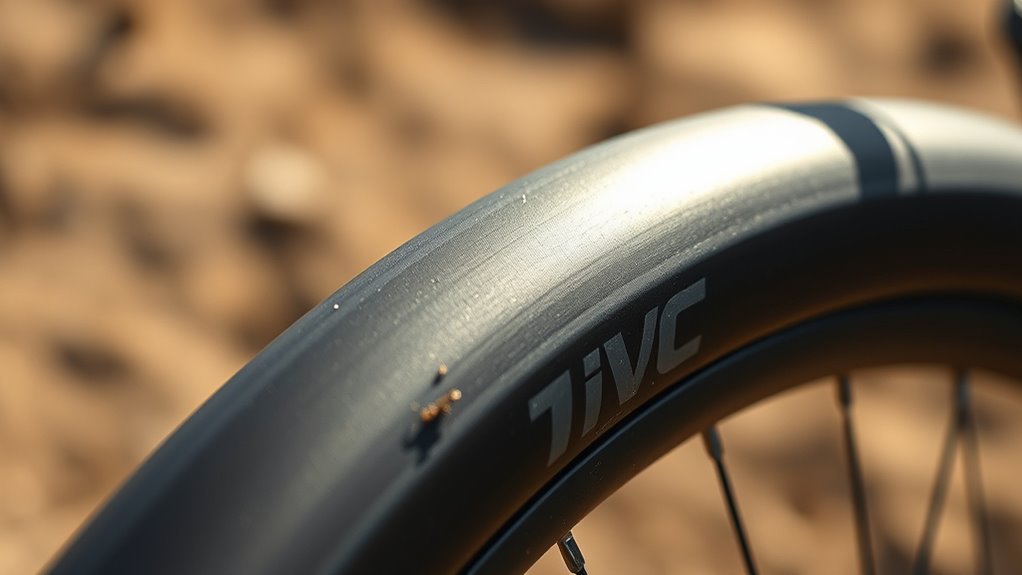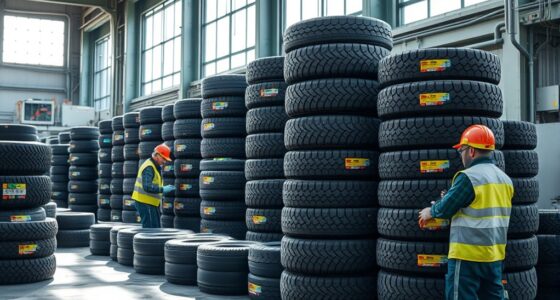Sustainability in off-road bike materials means choosing eco-friendly, recyclable components that help reduce environmental impact. By opting for lightweight yet durable recycled composites, you can enjoy better performance while supporting responsible manufacturing. These materials are designed to be processed and reused, preventing waste and pollution. Industry shifts toward greener practices and sustainable sourcing make your ride more eco-conscious. Keep exploring how innovative materials and practices can make your off-road adventures even more planet-friendly.
Key Takeaways
- Recyclable composites enhance durability and reduce environmental waste in off-road bike components.
- Eco-friendly manufacturing practices lower energy use and minimize harmful chemical emissions.
- Sustainable materials promote a circular lifecycle, enabling multiple recycling and extending bike lifespan.
- Industry innovation focuses on biodegradable and recyclable materials for improved performance and sustainability.
- Responsible sourcing and eco-certifications ensure environmentally conscious production aligned with sustainability goals.

As off-road biking continues to grow in popularity, the environmental impact of bike materials has become a key concern. You’re likely aware that traditional bike components often rely on materials that aren’t eco-friendly, contributing to pollution and waste. That’s why many manufacturers now focus on developing recyclable composites that reduce the ecological footprint of your bike. Recyclable composites are engineered to deliver the strength and durability you need while being easier to process and recycle at the end of their lifespan. By choosing bikes built with these materials, you help minimize landfill waste and promote a circular lifecycle for bike components.
Eco-friendly manufacturing plays a significant role in making off-road bikes more sustainable. Manufacturers are adopting greener processes, such as reducing energy consumption and cutting back on harmful chemicals used during production. These methods not only lessen environmental damage but also tend to produce higher-quality, longer-lasting bikes. When you purchase a bike made through eco-friendly manufacturing, you’re supporting industries that prioritize sustainability rather than short-term profit. This approach often involves sourcing raw materials responsibly, ensuring that the extraction and processing don’t harm ecosystems or communities.
Using recyclable composites in bike frames and parts isn’t just about environmental impact; it also benefits you as a rider. Bikes made from these materials tend to be lightweight yet strong, giving you better control and performance on rugged trails. Moreover, because these composites can be recycled multiple times, the lifecycle of your bike extends beyond just its initial use. When it’s time to upgrade or replace parts, you can be confident that your old components won’t end up polluting the environment. Instead, they can be processed and turned into new bike parts or other products, closing the loop in the manufacturing process.
More brands are integrating eco-friendly manufacturing practices into their production lines, recognizing that riders like you are increasingly conscious of sustainability. This shift encourages innovation, pushing the development of new biodegradable or recyclable materials that meet the demands of off-road biking. As you choose your next bike or upgrade, look for labels or certifications indicating the use of recyclable composites and eco-friendly production methods. Doing so makes a statement that you support responsible manufacturing and are committed to reducing your carbon footprint.
Additionally, the use of recyclable composites in bike components contributes to reducing waste and conserving resources, aligning with broader environmental sustainability goals. Ultimately, embracing recyclable composites and eco-friendly manufacturing isn’t just good for the environment; it also supports a sustainable future where off-road biking remains accessible for generations to come. Your choices as a rider can drive industry change, encouraging more companies to prioritize green practices and develop innovative, eco-conscious bike materials. Through mindful purchasing, you can enjoy your adventures knowing you’re contributing to a healthier planet.
Frequently Asked Questions
How Do Eco-Friendly Materials Impact Bike Performance?
Eco-friendly materials can enhance your bike’s performance by offering biomechanical benefits, like better shock absorption and weight reduction, which improve your riding experience. Plus, they often have unique aesthetic appeal, making your bike stand out while supporting sustainability. You might notice smoother rides and increased durability, all while knowing you’re making eco-conscious choices. These materials don’t just help the environment—they can also elevate your overall biking performance and style.
Are Sustainable Materials More Cost-Effective Long-Term?
Sustainable materials often save you money over time, with studies showing up to 30% lower maintenance costs. You’ll benefit from significant cost savings through durability and reduced need for replacements. Plus, you contribute to environmental benefits like lowering carbon footprints. While initial costs may be higher, the long-term savings and eco-friendly impact make sustainable materials a smart choice for your off-road bike.
What Are the Barriers to Adopting Sustainable Bike Components?
You might face barriers like market acceptance and supply chain challenges when adopting sustainable bike components. Many consumers still prefer traditional materials, making it harder to justify eco-friendly options. Additionally, sourcing sustainable materials can be complicated due to limited suppliers and longer lead times, which can increase costs and delays. Overcoming these hurdles requires educating consumers and building reliable supply networks to promote wider adoption of eco-friendly components.
How Do Recycled Materials Compare to Virgin Materials in Durability?
Durability differences between recycled and virgin materials depend on the recycling process and material sourcing. Recycled materials often match virgin ones in strength and resilience, but some may slightly falter if recycling isn’t thorough. You can count on quality when recycling processes are sophisticated, guaranteeing recycled components withstand rugged riding. Sourcing sustainable, high-grade recycled materials ensures durability, making recycled options a reliable, responsible choice for off-road biking without compromising performance.
Can Sustainable Materials Be Recycled After Bike End-Of-Life?
Yes, sustainable materials can be recycled after bike end-of-life. Recycling processes help extend the material lifecycle, reducing waste and environmental impact. When you choose bikes made from recyclable sustainable materials, you guarantee they can be broken down and repurposed, conserving resources and minimizing landfill accumulation. Proper recycling practices are essential, so always follow local guidelines to maximize the benefits of sustainable material reuse and support environmental efforts.
Conclusion
As you ride through rugged trails, imagine each pedal stroke made from eco-friendly materials quietly blending into the natural symphony around you. The coincidence of sustainability and performance isn’t just a dream—it’s the future you’re helping shape. With every off-road adventure, you’re not only pushing limits but also protecting the landscapes you cherish. Embrace these innovations, and let the harmony between rider and nature inspire your next ride.









